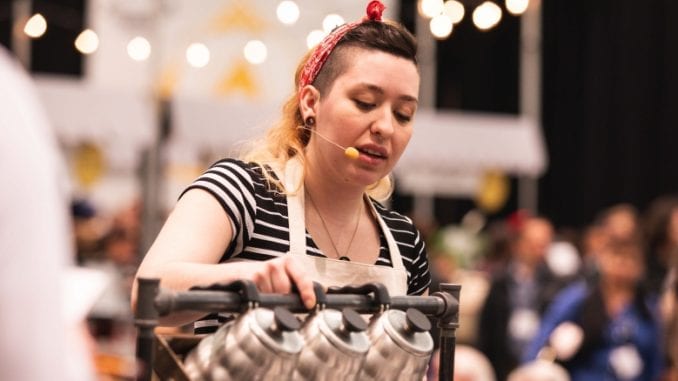
Becca Woodard won the 2018 United States Brewers Cup Championship with a stunning coffee and an innovative brewing technique. She shares her recipe and technique below.
BY ASHLEY RODRIGUEZ
BARISTA MAGAZINE ONLINE
Photos courtesy of Jake Olson for the SCA
Over the next few weeks, Barista Magazine Online will present a series of interviews with the winners and top finishers at this year’s United States Coffee Championships, which took place in Seattle in April. You can see a full list of winners, along with a rundown of the first and second round of the barista competition, as well as a livestream of the competition. We already spent a little time with Becca about her win—check out that interview here.
Becca Woodard of George Howell Coffee won the 2018 United States Brewers Cup Championship using an amazing coffee, a not-so-often used brewer, and a completely new brewing technique and tool to ensure she was able to brew all three cups of coffee required for the judges at the same time. In this interview, Becca shares her recipe, how she came up with the idea to control her water flow rate, and what’s to come for the world level.
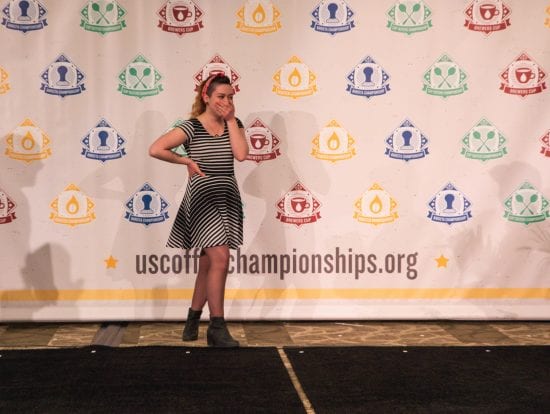
Ashley Rodriguez: Can you tell us about the coffee you used to compete?
Becca Woodard: The coffee I used is an experimentally processed Panamanian Gesha from the Ninety Plus Gesha Estate, Jose Alfredo Series of 2017 (lot# 236). It was grown under almost 100 percent canopy cover in the natural rainforest Joseph [Brodsky] and his team have been able to restore on the estate. Growing under so much shade, in volcanic soil that is constantly being fed by falling leaves, in the cool climate of the estate, slows development of the coffee cherries. The slow development leads to nutrient-rich trees that are extremely healthy, produce few defects, and live longer than the average coffee tree.
As far as the fermentation goes, I actually don’t know exactly how it was done! The details are kept secret, but I know it was fermented with the fruit using some select microorganisms and temperature control. We chose this coffee to compete with because the aroma and flavors are absolutely like no other coffee we’ve ever tasted before (even George himself had never tasted anything like it). The aroma is so incredibly floral, and overall the aroma and flavor are so complex, with layer after layer of clear-cut fruit and floral notes.
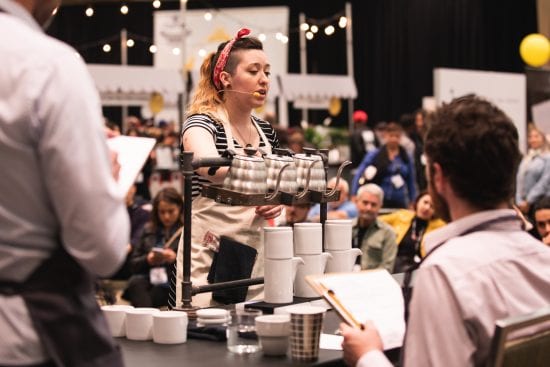
AR: What about your brewing method? I haven’t seen a ton of people go on stage with a Walkure Bayreuth—what were you able to get out of this brew method you weren’t with other devices?
BC: Yeah, the Walkure was interesting to work with! I had actually never used it before and only tried it on a kind of last-ditch effort. I tried the Clever dripper, AeroPress, Kalita Wave, V60 … I even tried preparing it cupping-style and passing it through a filter, but nothing I did preserved the complexity in flavor and the aroma.
The Walkure, however, is made up of four parts: the bottom chamber is just the server; it catches the brew and has a spout to pour from. The middle chamber has a double-layered cross-hatched ceramic grid, and it is where the coffee actually sits. Then there is a dispersion block on top of that, which is where you actually pour the water. A lid sits on top of that. The thing is that dispersion block has holes on the sides of it rather than on the bottom, so it acts as a lid the entire time you’re brewing, keeping the temperature more stable and locking in aroma. The ceramic grid suspends the brew bed and allows for “cake filtration” where the coffee puck actually filters itself, so on top of trapping in aroma you’re also getting a surprisingly clean cup with a whole lot of body. It’s kind of like taking the best parts of a full-immersion brew and the best parts of a pourover and combining them for the perfect cup!
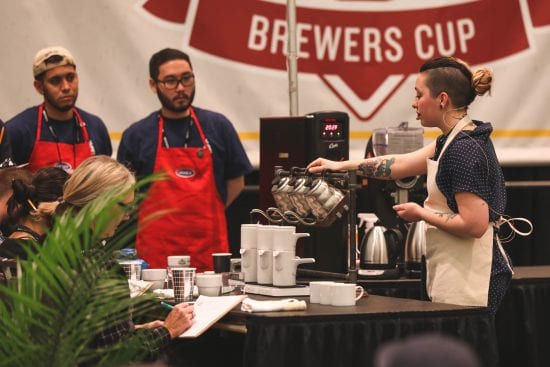
AR: OK, so let’s chat about the device you made to pour your kettles all at the same time … I’m not even sure what to call it? How did you come up with this? What did it enable you to do?
BC: I’m not sure what to call it either! Once I brewed the coffee on the Walkure, I knew I couldn’t serve it any other way, the only problem being it was damn near impossible to brew three of them in 10 minutes. I started trying to come up with ways to pour two kettles at a time, but I didn’t want two of the cups I served to be a wildly different temperature than the third brew.
I ended up talking it through with a few of my team members, and we started coming up with ideas on how to pour three at the same time. There were a few different concepts, but in the end a little bit of each idea played a part in the final product. We actually didn’t end up finishing the thing until about a week before the competition, and we quickly realized that no two kettles pour exactly the same. With some fiddling and experimenting, I found the exact weight to put in each kettle so they would pour evenly. It really helped to not only be able to be super-efficient and keep my cups very consistent, but I was able to focus more of my attention on the judges and what I was saying to them.
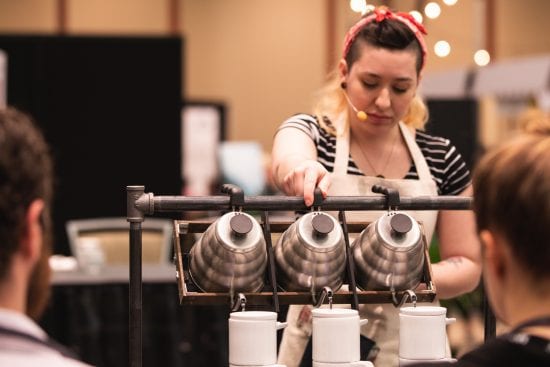
AR: Can you share the recipe you used for competition? Do you think it’ll change?
BC: For this coffee, I used a 14g dose ground on a medium/fine setting and a 235g yield. I started with a 40g/30-second bloom, and I shook the middle chamber to sort of stir up my slurry and make sure all the coffee was saturated. At 30 seconds I started pouring the rest of my total yield, very slowly, hitting the 235g mark at 2:30. It took till about 3:15-3:30 to draw down entirely. I will be using a different coffee for the world competition, so I’m not even sure if I’ll be using the Walkure again, but it will definitely be the first brew method I try!

